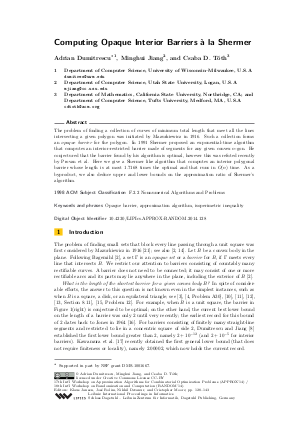Computing Opaque Interior Barriers à la Shermer
Authors Adrian Dumitrescu, Minghui Jiang, Csaba D. Tóth
-
Part of:
Volume:
Approximation, Randomization, and Combinatorial Optimization. Algorithms and Techniques (APPROX/RANDOM 2014)
Part of: Series: Leibniz International Proceedings in Informatics (LIPIcs)
Part of: Conference: International Conference on Randomization and Computation (RANDOM)
Part of: Conference: International Conference on Approximation Algorithms for Combinatorial Optimization Problems (APPROX) - License:
 Creative Commons Attribution 3.0 Unported license
Creative Commons Attribution 3.0 Unported license
- Publication Date: 2014-09-04
File

PDF
LIPIcs.APPROX-RANDOM.2014.128.pdf
- Filesize: 0.61 MB
- 16 pages
Document Identifiers
Subject Classification
Keywords
- Opaque barrier
- approximation algorithm
- isoperimetric inequality
Metrics
- Access Statistics
-
Total Accesses (updated on a weekly basis)
0PDF Downloads0Metadata Views
Abstract
The problem of finding a collection of curves of minimum total length that meet all the lines intersecting a given polygon was initiated by Mazurkiewicz in 1916. Such a collection forms an opaque barrier for the polygon. In 1991 Shermer proposed an exponential-time algorithm that computes an interior-restricted barrier made of segments for any given convex n-gon. He conjectured that the barrier found by his algorithm is optimal, however this was refuted recently by Provan et al. Here we give a Shermer like algorithm that computes an interior polygonal barrier whose length is at most 1.7168 times the optimal and that runs in O(n) time. As a byproduct, we also deduce upper and lower bounds on the approximation ratio of Shermer's algorithm.
Cite As Get BibTex
Adrian Dumitrescu, Minghui Jiang, and Csaba D. Tóth. Computing Opaque Interior Barriers à la Shermer. In Approximation, Randomization, and Combinatorial Optimization. Algorithms and Techniques (APPROX/RANDOM 2014). Leibniz International Proceedings in Informatics (LIPIcs), Volume 28, pp. 128-143, Schloss Dagstuhl – Leibniz-Zentrum für Informatik (2014)
https://doi.org/10.4230/LIPIcs.APPROX-RANDOM.2014.128
BibTex
@InProceedings{dumitrescu_et_al:LIPIcs.APPROX-RANDOM.2014.128,
author = {Dumitrescu, Adrian and Jiang, Minghui and T\'{o}th, Csaba D.},
title = {{Computing Opaque Interior Barriers \`{a} la Shermer}},
booktitle = {Approximation, Randomization, and Combinatorial Optimization. Algorithms and Techniques (APPROX/RANDOM 2014)},
pages = {128--143},
series = {Leibniz International Proceedings in Informatics (LIPIcs)},
ISBN = {978-3-939897-74-3},
ISSN = {1868-8969},
year = {2014},
volume = {28},
editor = {Jansen, Klaus and Rolim, Jos\'{e} and Devanur, Nikhil R. and Moore, Cristopher},
publisher = {Schloss Dagstuhl -- Leibniz-Zentrum f{\"u}r Informatik},
address = {Dagstuhl, Germany},
URL = {https://drops.dagstuhl.de/entities/document/10.4230/LIPIcs.APPROX-RANDOM.2014.128},
URN = {urn:nbn:de:0030-drops-46938},
doi = {10.4230/LIPIcs.APPROX-RANDOM.2014.128},
annote = {Keywords: Opaque barrier, approximation algorithm, isoperimetric inequality}
}
